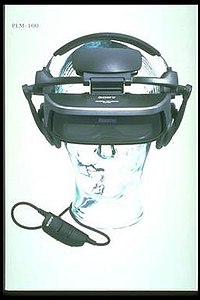Glasstron
 | |
| Manufacturer | Sony |
|---|---|
| Product family | Glasstron |
| Type | Head-mounted display |
The Sony Glasstron was a family of portable head-mounted displays, first released in 1996 with the model PLM-50.[1][2] The products included two LCD screens and two earphones for video and audio respectively. These products are no longer manufactured nor supported by Sony.[citation needed]
The Glasstron was not the first head-mounted display by Sony, with the Visortron being a previous exhibited unit.[3][4] The Sony HMZ-T1, HMZ-T2, HMZ-T3 and PlayStation VR can be considered successors to Glasstron.[2] The head-mounted display developed for Sony during the mid-1990s[which?] by Virtual i-o is completely unrelated to the Glasstron.[1]
One application of this technology was in the game MechWarrior 2, which permitted users to adopt a visual perspective from inside the cockpit of the craft, using their own eyes as visual and seeing the battlefield through their craft's own cockpit.[5]
Models
Five models were released.[citation needed] Supported video inputs included PC (15 pin, VGA interface), Composite and S-Video. A brief list of the models follows:
| Model number | Year of release | Notes |
|---|---|---|
| PLM-50 | 1996[6] | Released June 1996 in Japan.[6] |
| PLM-A35 | 1997[7] | The most basic model with opaque lenses and has SVGA input.[citation needed] Released June 1997 in USA.[7] |
| PLM-A55 | 1997[7] | This model had a mechanical shutter to allow the display to become see through, without SVGA.[citation needed] Released June 1997 in USA.[7] |
| PLM-100 | 1998[citation needed] | This model had a mechanical shutter to allow the display to become see through, with SVGA, somewhat unstable.[citation needed] |
| PLM-S700 / PLM-S700E | 1998[8] | The S700 allowed for see through mode using LCD shutters and had support for SVGA output.[citation needed] Its LCD had over 1.55 million pixels on a component the size of a ten-cent coin at SVGA (800×600) display resolution.[citation needed] The S700 has NTSC input, whilst the S700E has PAL input. The S700 was released on 10 November 1998 in Japan.[8] |
References
- ^ a b "Reality Check". Electronic Gaming Monthly. No. 85. Ziff Davis. August 1996. pp. 14–16.
- ^ a b McCracken, Harry (2 February 2012). "Sony's Highly Personal, Surprisingly Decent 3D Viewer". Time. Retrieved 23 September 2016.
- ^ "Visortron". Baltimore Sun. AP. 10 October 1995. Retrieved 23 September 2016.
- ^ Free, John (1993). "Electronics Newsfront: ...and Visortrons from Japan". Popular Science (March 1993): 26. Retrieved 23 September 2016.
- ^ Tony Sperry. Beyond 3D TV, Lulu Pres, Inc., November 2003.
- ^ a b "Sony Corporate Info: Projector Head Mounted Display". Sony. Retrieved 23 September 2016.
- ^ a b c d "VR Wiki: Sony". VR Wiki. Retrieved 23 September 2016.
- ^ a b "Sony Announces New Personal LCD Monitor PC Glasstron". Sony. 29 September 1998. Retrieved 23 September 2016.
